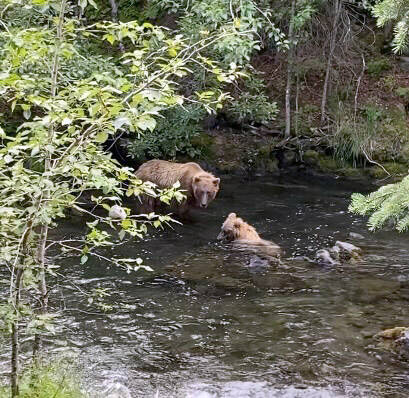Anglers and bears spend more time on the river as the first run of salmon makes its way upstream. While the rivers and tributaries offer a natural and abundant food source for bears, bears are opportunistic and will feed on the most accessible food source.
A fish stringer not closely attended provides space for a bear to approach and get your hard-caught fish. A backpack filled with lunch is another hard temptation to resist.
As anglers catch and clean salmon, carcasses float downstream and stack up in slow eddies along the riverbank. The consistent carcasses in the eddies become another major attractant to bears. It is much harder to catch a live fish.
As bears continue receiving repeated food rewards from us or our fishing neighbors beside us, they regularly “hang around” people on the river or at campsites — we call this habituated.
They begin a habit of focusing on food people might provide and less on the fish in the river. Before long, they become bolder and start approaching anglers on the bank or at the fish cleaning tables.
Some people see the bear at the fish table and toss them a chunk of fish, much like the seagulls waiting nearby. But feeding bears puts them on a path of being so bold around people that they can become dangerous.
As they begin associating people with food, they eventually get emboldened around people. They will try to get into cars, campers or tents, or charge people while fishing. And that’s when their and our nature come into conflict.
Preventing food conditioning of bears reduces the potential for human-bear conflicts, and multiple agencies working at the Russian River focus on educating the public on best practices.
Rangers and Streamwatch volunteers talk to the anglers, reminding them to take fish out whole and to keep backpacks and stringers close. Food storage regulations are in place, and when complied with, these rules ensure that bears don’t have access to human-generated foods and other attractants.
Many of us might spend a week or a few days on the river or in the campgrounds, and it seems hard to believe that our short time will matter. However, each angler or camper that provides a food reward builds on one another, putting bears on a path of becoming habituated and emboldened around people. We can stop that process.
You can do a few things to ensure that our enjoyment of bears and their pursuit of easily attainable food does not lead to conflict when we share the river and campgrounds with them.
While fishing:
1. Keep your backpack within 3 feet of you at all times.
2. Keep your fish stringer at least 12 feet or closer to you.
3. Bears are attracted to splashing fish; if a bear approaches when you have a fish on the line, put slack on your line or cut the line and let the current take the fish away from the bear.
Cleaning your fish:
1. Remove the fish whole and clean your fish at home. To reduce the smells and odor in your trash cans, and avoid attracting bears at home, put all fish carcasses in a garbage bag and freeze before trash day.
2. Avoid cleaning fish on the river; if you do, STOP, CHOP, AND THROW. Whole salmon carcasses are more likely to back up in eddies along the river and provide a smorgasbord for bears.
3. If you do use the fish cleaning table and see a bear nearby, this would be a good day to take your fish out whole and clean and fillet it at home.
Being smart around bears continues beyond the river. If you stay in U.S. Forest Service or Kenai National Wildlife Refuge campgrounds, know and comply with all food storage regulations.
1. Never leave food unattended on picnic tables, and when you are finished:
a. Store all food, beverages, garbage and all equipment used to transport or store these items (for example, coolers and backpacks) locked in a hard-sided vehicle or camper, in a commercially produced bear resistant container, or within immediate grasp, which means within 3 feet of the person at all times.
b. You can also store food in bear-resistant coolers with a lock. For less than 25 cents, a bolt and nut work to lock the cooler, or you can purchase a $40 bicycle lock from the cooler manufacturer.
2. All lawfully retained fish should be locked in a hard-sided vehicle or camper, in a commercially produced bear resistant container, or closely attended, which means within 12 feet of the person.
3. Store waders and coats that may have fishing odors in your locked car.
4. Keep pets on a leash no greater than 6 feet in length.
5. NEVER feed bears!
It takes each of us to practice these steps; while you might only be on the river or in the campground for a short time, each time a bear receives a food reward, it becomes food-conditioned and bolder around people. This behavior increases the risk to public safety and, almost inevitably, does not end well for the bear.
If each of us practiced these steps, our experiences on the river would be more of one where bears are fishing for live fish at a distance. Now, that would be truly WILD!
This article was adapted from the July 20, 2023, Refuge Notebook article. Kris Inman is the supervisory wildlife biologist at the Kenai National Wildlife Refuge. She studied black bears for nearly a decade and nine more years working with local communities to reduce conflicts with bears.
You can find more information about bear safety at https://www.adfg.alaska.gov/index.cfm?adfg=livingwithbears.main or about the Refuge at http://kenai.fws.gov or http://www.facebook.com/kenainationalwildliferefuge. Also, look for Refuge Notebook Articles on the first Friday of each month or Find past Refuge Notebook articles (1999–present) at https://www.fws.gov/kenai-refuge-notebook.

